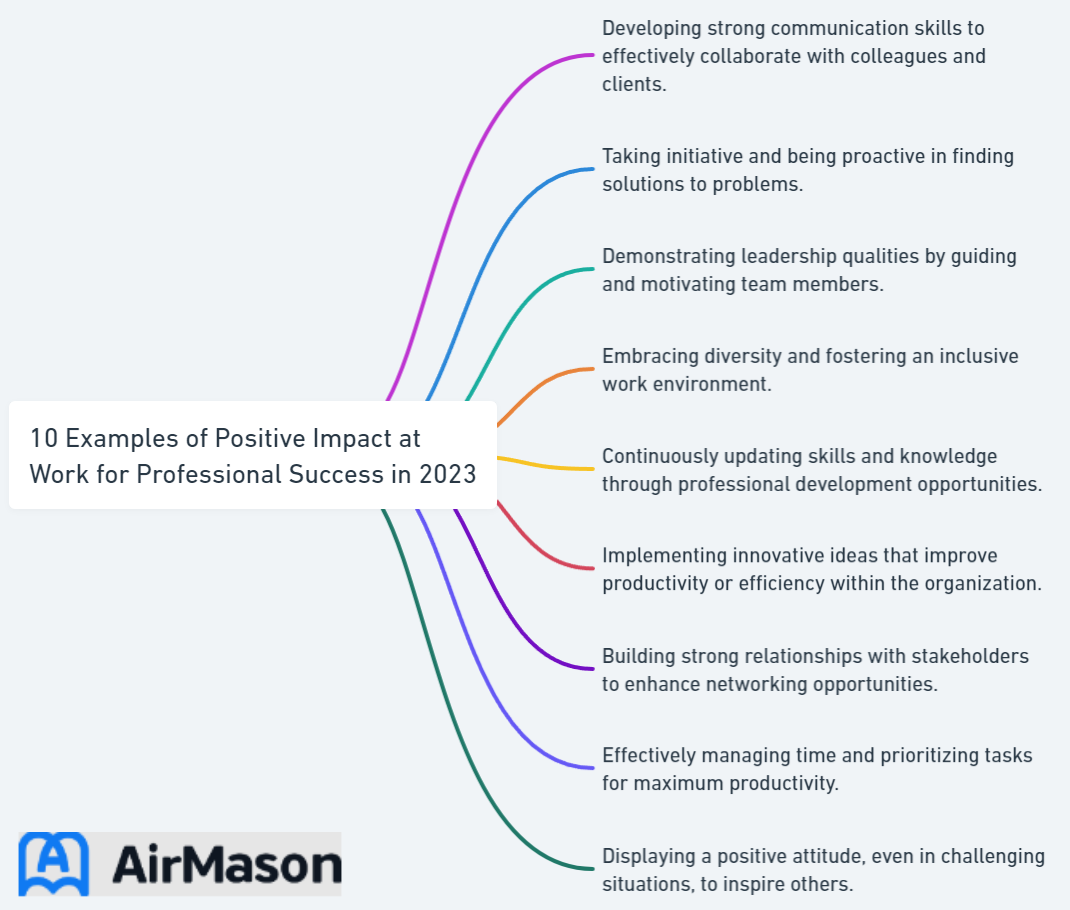
In today’s fast-paced and ever-changing work environment, making a positive impact at work can be the defining factor in achieving professional success. But how do you create that impact? In this blog post, we’ll uncover ten powerful strategies and examples of positive impact at work, helping you rise above the competition, boost your career, and inspire those around you.
Key Takeaways
- Create a positive work environment and foster collaboration
- Encourage open communication, recognize achievements & reward success
- Invest in professional development, mentor colleagues & prioritize work-life balance to reach success.
Creating a Positive Work Environment
A positive work environment is the foundation of employee satisfaction, productivity, and overall success. Using employee handbook examples and templates can help establish workplace policies and procedures.A positive atmosphere that boosts morale and keeps your team motivated can be fostered by encouraging collaboration, promoting open communication, and recognizing achievements.
Read on to discover how these three key elements can make an impact and create a lasting impact at work.

Encourage Collaboration
We’ve all heard the saying, “teamwork makes the dream work.” Collaboration is the driving force behind increased productivity, innovation, and improved teamwork. An employee handbook builder makes it easy to customize policies for your unique workplace needs. Fostering collaboration can elevate your team’s performance and leave a lasting impression on your organization.
One way to encourage collaboration is by offering both positive and constructive feedback to your team members. While it’s important to recognize their hard work and achievements, it’s also crucial to provide constructive feedback to help them identify areas for improvement and growth. Offering timely and specific feedback can help in boosting employee morale, particularly when they are feeling overwhelmed or stressed. Remember to celebrate and recognize teamwork when your team delivers high-quality work.
Promote Open Communication

Open communication is the key to building trust, promoting transparency, and encouraging successful problem-solving. Using the top employee handbook software streamlines policy management. Open communication channels can help in creating a positive work culture that leads to increased employee engagement and overall success.
One way to promote open communication is by:
- Being receptive to others’ perspectives and suggestions
- Demonstrating your willingness to provide assistance and guidance
- Raising any queries or concerns with the appropriate people
Transparency in communication can help you find resolutions rather than fuel additional conflict, which enables you to make progress and improve employee morale.
Remember, poor communication can impede your progress and harm your relationships with colleagues, so make an effort to cultivate positive behavior and strong communication skills in your workplace.
Understanding an Organization’s Culture
An organization’s culture embodies the shared values, beliefs, and behaviors that define its identity and shape the way its members interact and work together. It encompasses the unwritten norms that guide decision-making, communication, and problem-solving. An organization’s culture is not static; it evolves over time, influenced by its history, leadership style, and external factors. This intangible yet powerful force plays a pivotal role in determining the overall effectiveness and success of an organization. It sets the tone for how employees engage with their tasks, colleagues, and the broader mission of the organization. Therefore, comprehending and actively cultivating a positive, inclusive, and aligned organizational culture is paramount for achieving sustained growth and fostering a thriving work environment.
Recognize and Reward Achievements
Recognizing and rewarding achievements is a powerful way to increase employee morale, motivation, and engagement. Celebrating the remarkable work of your team members sends a clear message that leadership with a positive mindset is highly valued and actively encouraged within your organization.
One way to recognize and reward achievements is by giving positive feedback when employees get promoted or take on new responsibilities. This shows your appreciation and motivates them to strive for even greater success. Moreover, recognizing and rewarding achievements can boost self-esteem and inspire others to follow suit, ultimately enhancing employee engagement. Be sure to celebrate your team’s successes in meetings or through encouraging messages, ensuring that your positive feedback is seen and felt.
Demonstrating a Positive Attitude

Your attitude can significantly impact your workplace culture and personal success. Embracing challenges and adopting a solution-oriented mindset can inspire those around you to follow suit and strive for greatness.
In the following sections, we’ll delve into:
- The importance of embracing challenges
- Being solution-oriented
- Equipping you with the tools and mindset to make a positive impact on your team and organization.
Embrace Challenges
Embracing challenges means viewing obstacles as opportunities for growth and learning. Fostering resilience and adaptability can positively impact your professional success. Embracing challenges in the professional field can open up a world of opportunities, including:
- Personal and professional growth
- Increased confidence
- Improved problem-solving skills
- Enhanced creativity and innovation
- Career advancement
It also equips individuals with valuable skills such as resilience, adaptability, and the ability to handle pressure, which are essential for success in today’s competitive work environment and can boost morale among team members.
So, how can you embrace challenges? Start by reframing your mindset and seeing challenges as opportunities for growth. When faced with a difficult task, remember that overcoming obstacles can lead to new skills, increased confidence, and a greater sense of accomplishment. Don’t shy away from taking calculated risks and stepping out of your comfort zone; instead, approach challenges with a positive attitude and a willingness to learn.
Be Solution-Oriented
Adopting a solution-oriented mindset is crucial for tackling problems effectively and inspiring others to do the same. Focusing on finding solutions rather than dwelling on problems can positively impact your team’s success. A solution-oriented approach can:
- Foster a proactive attitude
- Promote collaboration and teamwork
- Strengthen trust and confidence
- Boost motivation and engagement
- Lead by example
To cultivate a solutions-based mindset, start by:
- Identifying the root cause of a problem
- Brainstorming potential solutions
- Seeking out advice and opinions from colleagues, as they might provide fresh perspectives and innovative ideas
- Remembering that collaboration is key, so don’t be afraid to ask for help or offer assistance when needed.
Being solution-oriented not only contributes to your own success but also inspires your team members to follow suit, creating a positive and supportive work environment where everyone can find all the answers they need.
Going the Extra Mile

Going the extra mile can lead to professional success and recognition. Whether it’s taking on additional tasks, volunteering for extra job activities, or providing exceptional customer service, your dedication and commitment to going above and beyond can make a lasting impact on your organization.
In the following sections, we’ll explore how to exceed expectations and offer support to colleagues, setting yourself apart as a true team player.
Exceed Expectations
Consistently exceeding expectations in your work demonstrates your commitment to excellence, setting you apart from your peers and showcasing your willingness to go the extra mile. Taking initiative, demonstrating creativity, and consistently meeting deadlines can leave a lasting impression on your organization and contribute to your team’s success. By striving to deliver high quality work, you further solidify your value within the company.
To exceed expectations, start by taking ownership of your work and proactively identifying areas for improvement. Seek out new challenges and opportunities for growth, and be willing to lend a hand to your colleagues when needed. Strive for excellence in everything you do, from the quality of your work to the way you communicate with your team members. By going above and beyond, you not only demonstrate your value to the organization, but also inspire others to follow suit.
Offer Support to Colleagues
Offering support and assistance to your colleagues is an essential aspect of going the extra mile. Being there for your team members when they need you can foster a collaborative and helpful work environment that promotes success for everyone involved.
To offer support to your colleagues, you can:
- Be proactive in identifying their needs and offering assistance
- Share your knowledge and expertise
- Be open to learning from others
- Encourage open communication and collaboration
- Celebrate your team’s successes together
By being a supportive team player, you not only contribute to the overall success of your organization but also create a positive and nurturing work environment for your colleagues as a valuable team member.
Enhancing Customer Satisfaction

Enhancing customer satisfaction is crucial for the success of any business. Delivering exceptional service and implementing feedback can create a lasting impact on your organization and contribute to its continued growth.
In this section, we’ll explore how to deliver exceptional service and seek and implement customer feedback to improve customer experiences.
Deliver Exceptional Service
Providing exceptional customer service is all about understanding and addressing individual needs and preferences. Going above and beyond to ensure that your customers are satisfied can significantly impact your organization’s success. Companies like:
- Zappos
- JetBlue
- Tesla
- Southwest Airlines
These companies are one of the best at providing personalized service and making a positive impact on customer satisfaction and loyalty through positive feedback examples.
To deliver exceptional service, start by actively listening to your customers and empathizing with their needs. Be proactive in finding solutions to their problems and be willing to go the extra mile to ensure their satisfaction. Maintain open communication channels and be responsive to their concerns. By demonstrating a genuine commitment to your customers’ happiness, you not only create loyal customers but also contribute to the overall success of your organization.
Seek and Implement Feedback
Seeking and implementing customer feedback is essential for continuous improvement and enhanced customer satisfaction. Actively gathering and utilizing customer feedback can help identify areas for improvement and positively impact your organization’s success.
Some effective methods for seeking customer feedback include:
- Customer surveys
- Email and contact forms
- Usability tests
- Interviews and focus groups
- Social media
- Website analytics
- Free-text feedback
Once you’ve gathered feedback, use it to pinpoint areas of improvement in service quality and customer satisfaction, implement changes, and continually reassess your progress.
By actively seeking and implementing customer feedback, you not only improve your organization’s performance but also create a lasting impact on customer satisfaction and loyalty.
Culture and Conduct Learning Check Answer Key
The “Culture and Conduct Learning Check Answer Key” serves as a crucial resource in evaluating an individual’s comprehension of the essential principles governing workplace behavior and organizational values. This comprehensive guide provides a detailed breakdown of correct responses, enabling learners to gauge their proficiency in navigating various cultural scenarios and ethical dilemmas within the professional sphere. By referencing the “Culture and Conduct Learning Check Answer Key,” individuals can identify areas of strength and pinpoint specific areas that may require further attention or development. Moreover, this key empowers organizations to track and measure the progress of their employees in cultivating a positive and inclusive work environment. It stands as a valuable tool in reinforcing the importance of cultural sensitivity and ethical conduct, fostering an atmosphere of respect and integrity within the workplace. With its precise feedback, the answer key encourages ongoing learning and growth, ultimately contributing to a more harmonious and productive organizational culture.
Investing in Professional Development

Investing in professional development is essential for personal growth and improved workplace performance. Pursuing new skills and sharing your expertise with colleagues can positively impact both your own success and the success of your team.
In this section, we’ll explore how to pursue new skills and knowledge and share expertise with your colleagues.
Pursue New Skills and Knowledge
Actively pursuing new skills and knowledge can help you stay competitive in the workplace and contribute to your team’s success. Continual learning and growth not only enhances your own abilities but also inspires those around you to do the same.
To pursue new skills and knowledge, consider taking courses, attending seminars, or reading books related to the desired skill. By investing in your professional development, you can unlock new opportunities for growth, increase your value to the organization, and ultimately achieve greater success in your career.
Share Expertise with Colleagues
Sharing your expertise with colleagues is an essential aspect of fostering a culture of continuous learning and improvement. Offering knowledgeable advice, providing mentorship, and collaborating on projects can positively impact your colleagues’ professional growth and success.
Some ways to share your expertise with colleagues include leading workshops, participating in knowledge-sharing sessions, and offering one-on-one guidance and mentorship. By sharing your knowledge and expertise, you not only contribute to the overall success of your organization but also create a supportive and nurturing work environment for your team members.
Embracing Leadership Opportunities

Embracing leadership opportunities is an essential aspect of making an impact and creating a positive impact at work. Taking initiative and mentoring others can inspire growth and development in both yourself and your team members.
In this section, we’ll explore how to take initiative and mentor others in order to make a lasting impact on your organization.
Take Initiative
Taking initiative in the workplace is an excellent way to showcase your value to the organization and contribute to your team’s success. Proactively assessing situations and taking action demonstrates your ability to think ahead, bring creative ideas, and go the extra mile to ensure successful outcomes.
One way to take initiative in your professional development is by enrolling in an online course to learn a new coding language. By demonstrating your commitment to excellence and your willingness to take on new challenges, you not only stand out among your peers but also inspire others to follow suit.
Mentor and Support Others
Mentoring and supporting colleagues is crucial for fostering a culture of growth, development, and collaboration. By offering guidance, sharing your knowledge, and providing encouragement, you can make a positive impact on your colleagues’ professional growth and success.
Establishing mentoring circles or programs, encouraging knowledge sharing, and creating a supportive work environment are just a few ways you can mentor and support others in your workplace. By investing in the growth and development of your colleagues, you not only contribute to the overall success of your organization but also create a positive and nurturing work environment for everyone involved.
A Collaborative Business Culture is Characterized By
A collaborative business culture is characterized by a strong emphasis on teamwork and open communication. In such an environment, employees are encouraged to share their ideas, knowledge, and skills, fostering a sense of unity and collective purpose. Collaboration extends beyond individual teams, as different departments and levels within the organization work together towards common goals. This culture values diversity of thought and recognizes that each team member brings unique strengths to the table. Moreover, a collaborative business culture often promotes a flat organizational structure, where hierarchies are minimized, and decision-making is more inclusive, allowing for greater participation from all members of the team. This inclusive approach not only leads to increased innovation but also promotes a sense of ownership and accountability among employees.
Prioritizing Work-Life Balance

Prioritizing work-life balance is essential for overall well-being and productivity. Setting boundaries and encouraging self-care among team members can create a healthy work environment that promotes success for everyone involved.
In this section, we’ll explore strategies for setting boundaries and encouraging self-care in the workplace.
Set Boundaries
Setting boundaries between work and personal life is crucial for maintaining a healthy balance and preventing burnout. By establishing personal goals and limits, you can promote a healthy work-life balance and reduce the risk of burnout.
Some strategies for setting boundaries in the workplace include prioritizing important activities, reflecting on your self-care needs, and creating clear boundaries between work and personal life. By setting and maintaining healthy boundaries, you can enjoy reduced stress, improved mental and physical health, and increased job satisfaction, all of which contribute to your overall well-being and productivity.
Encourage Self-Care Among Team Members
Encouraging self-care among team members is vital for promoting a supportive and understanding work culture. By fostering a healthy work environment that supports boundaries and self-care, you can ensure the well-being and productivity of your colleagues.
To encourage self-care, promote open communication and collaboration, and provide resources and support for your team members, follow these steps:
- Recognize and reward achievements.
- Encourage team members to take breaks, practice self-care, and prioritize their well-being.
- Create a supportive and nurturing work environment.
- Foster open communication and collaboration.
- Provide resources and support for your team members.
By following these best ways to make improvements, you not only contribute to the overall success of your organization but also make sure to create a positive and thriving workplace for your colleagues.
Giving and Receiving Constructive Feedback

Giving and receiving constructive feedback, including negative feedback, is crucial for personal and professional growth. Offering timely, specific feedback and seeking feedback for your own development can foster a culture of continuous improvement and make a lasting impact on your organization.
In this section, we’ll explore strategies for offering and receiving feedback in the workplace.
Offer Timely and Specific Feedback
Providing timely and specific feedback to colleagues is essential for reinforcing positive behaviors and addressing areas for improvement. By delivering effective feedback in a motivating way, you can inspire your colleagues to continue growing and developing.
To offer timely and specific feedback, start by offering positive feedback close to the event and being specific with your compliments. For example, instead of saying “good job,” try saying, “I’m incredibly proud of how you took the initiative to grow in your role. You’re setting a great example for others – well done!”.
By providing constructive feedback in a respectful and professional manner, you can build strong relationships with your colleagues and contribute to their professional growth and success.
Seek Feedback for Personal Growth
Seeking feedback from colleagues and managers can help you identify your strengths and areas for growth, fostering a culture of continuous improvement within your organization. By actively seeking feedback and using it for your personal and professional development, you can unlock your full potential and make a lasting impact on your workplace.
To seek feedback for personal growth, follow these steps:
- Be open-minded and receptive to constructive criticism.
- Recognize your strengths and weaknesses, and use feedback as an opportunity for development.
- Schedule regular feedback sessions.
- Ask the right questions to gather valuable insights.
- Maintain a growth mindset, always looking for ways to improve and enhance your performance.
- By seeking feedback and using it for personal growth, you not only contribute to your own success but also inspire your colleagues to do the same.
Bottom Line on Positive Impact Examples
In conclusion, making a positive impact at work is essential for achieving professional success in today’s competitive work environment. By creating a positive work environment, demonstrating a positive attitude, going the extra mile, enhancing customer satisfaction, investing in professional development, embracing leadership opportunities, prioritizing work-life balance, and giving and receiving constructive feedback, you can make a lasting impact on your organization and inspire those around you to do the same. The power to make a difference lies within you – embrace it and watch your career soar!
FAQs about Examples of Positive Impact at Work
What is an example of impact at work?
Making an effort to help out a coworker, offering feedback to improve processes, taking on tasks outside of your comfort zone, and being a positive presence are all ways to make a meaningful impact at work.
How can you make a positive impact in the workplace?
Make a positive impact at work by taking initiative and proactively leading initiatives, keeping stakeholders informed, being reliable, solving problems, taking ownership of your role, and going the extra mile.
What is one example of a positive impact that someone can make?
By simply taking the time to acknowledge and inspire someone, we can make a positive impact on their life. Acknowledging their efforts, talents, and resilience lets them know they are valued and appreciated.
How can I foster collaboration in my team?
Motivate your team with open communication, feedback and rewards for working together to achieve great results.
What are some ways to promote open communication in the workplace?
Encourage dialogue and be open to other’s ideas, show you’re willing to help, and always take the initiative to raise any issues that arise. Foster an environment of mutual respect and positive communication!